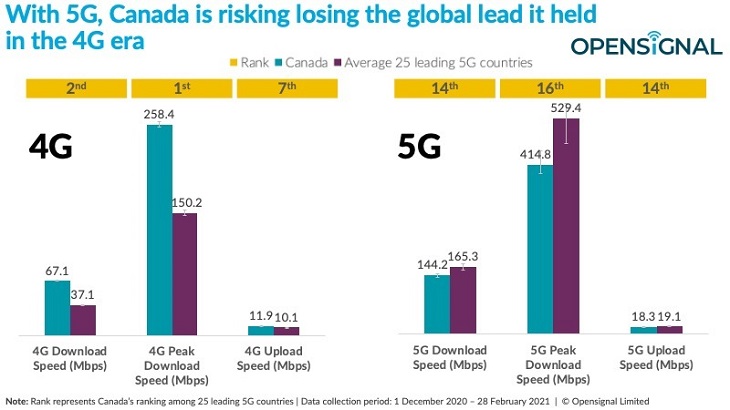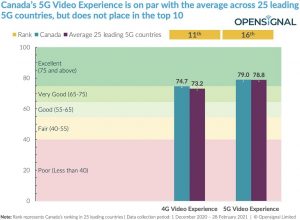
LONDON, U.K. — While the 4G networks of Canada’s Big Three national operators are among the fastest in the world, their 5G network performance trails operators in other countries, primarily due to spectrum delays faced in Canada, according to a new report from U.K.-based mobile analytics company Opensignal, released Wednesday.
To conduct its research, Opensignal analyzed the current real-world 5G experience of its app users on Canada’s three largest mobile operators — Bell, Rogers and Telus — in terms of average download and upload speeds and their experience when streaming mobile video and compared it to the average 5G experience of Opensignal’s users in 25 leading 5G countries. Measurement data for this report was collected between December 1, 2020 and February 28, 2021.
As can be seen above, Opensignal ranks the 4G network speeds of Canada’s national operators in the top 10 compared to the average 4G speeds among 25 leading 5G countries, across several metrics, including a first-place ranking for a 4G peak download speed of 258.4 Mbps and a second-place ranking for an average 4G download speed of 67.1 Mbps. Canada’s national operators ranked seventh globally in terms of average 4G upload speed (11.9 Mbps).
However, when connected to 5G, Opensignal’s app users in Canada experienced an average 5G download speed of 144.2 Mbps, ranking Canada 14th overall. Canada ranks lower (16th) when it comes to 5G peak download speed, achieving 414.8 Mbps, which is significantly less than the 529.4 Mbps average 5G peak download speed reported for the 25 leading 5G countries. Canada ranked 14th globally for an average 5G upload speed of 18.3 Mbps.
On a positive note, looking at the experience of Opensignal’s smartphone users when streaming video over mobile connections, Canadian users enjoyed an “excellent” video experience (score of 75 or above) when connected to 5G. In comparison, the 4G video experience for Canadian users was rated “very good” (score between 65-75). However, Canada ranked 16th globally and 11th for 4G video experience compared to the same group of countries Opensignal measured.
“Our analysis shows that Canadian users continue to benefit from some of the fastest 4G experiences globally, but this is not yet true for 5G. Canada’s leading operators are well into the 5G deployment cycle, but the 4G/5G uplift in Canada’s user experience has been lower than what their peers in other 5G countries have seen,” reads Opensignal’s report.
The lower 5G performance is because Canada’s operators are limited to deploying it in lower spectrum bands since the auction of 3.5 GHz mid-band spectrum, critical for next-gen wireless, was delayed until June 2021 due to Covid-19, explains the report.
Opensignal’s report also notes Canada’s auction will make only 200 MHz of spectrum available in the 3.5 GHz band — a maximum of 150 MHz for Bell, Rogers and Telus, and a 50 MHz set-aside — which is “significantly less compared to many other 5G countries,” says the report. The measurement company also points out the ITU’s minimum technical requirements to meet the IMT-2020 criteria for 5G specifies at least 100 MHz of spectrum per operator, which allows the full capabilities of 5G to be realized through wider channel sizes in the new 5G bands.
“In future, Canada’s operators need access to comparable amounts of new 5G spectrum to operators in other countries. Otherwise, if Canada’s operators are forced to continue to rely on re-using existing spectrum for 5G, or lower frequency bands for 5G that offer great coverage but lower capacity, then Canada risks falling behind in the global 5G race for offering the best mobile network experience,” concludes Opensignal’s report.
To access the report, please click here.




